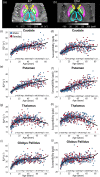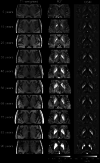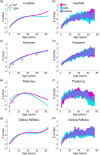R2* and quantitative susceptibility mapping in deep gray matter of 498 healthy controls from 5 to 90 years
- PMID: 34184808
- PMCID: PMC8410539
- DOI: 10.1002/hbm.25569
R2* and quantitative susceptibility mapping in deep gray matter of 498 healthy controls from 5 to 90 years
Abstract
Putative MRI markers of iron in deep gray matter have demonstrated age related changes during discrete periods of healthy childhood or adulthood, but few studies have included subjects across the lifespan. This study reports both transverse relaxation rate (R2*) and quantitative susceptibility mapping (QSM) of four primary deep gray matter regions (thalamus, putamen, caudate, and globus pallidus) in 498 healthy individuals aged 5-90 years. In the caudate, putamen, and globus pallidus, increases of QSM and R2* were steepest during childhood continuing gradually throughout adulthood, except caudate susceptibility which reached a plateau in the late 30s. The thalamus had a unique profile with steeper changes of R2* (reflecting additive effects of myelin and iron) than QSM during childhood, both reaching a plateau in the mid-30s to early 40s and decreasing thereafter. There were no hemispheric or sex differences for any region. Notably, both R2* and QSM values showed more inter-subject variability with increasing age from 5 to 90 years, potentially reflecting a common starting point in iron/myelination during childhood that diverges as a result of lifestyle and genetic factors that accumulate with age.
Keywords: R2*; aging; brain iron; deep gray matter; development; lifespan; susceptibility.
© 2021 The Authors. Human Brain Mapping published by Wiley Periodicals LLC.
Figures






Similar articles
-
Spatiotemporal variations of magnetic susceptibility in the deep gray matter nuclei from 1 month to 6 years: A quantitative susceptibility mapping study.J Magn Reson Imaging. 2019 Jun;49(6):1600-1609. doi: 10.1002/jmri.26579. Epub 2018 Dec 19. J Magn Reson Imaging. 2019. PMID: 30569483
-
Subcortical gray matter segmentation and voxel-based analysis using transverse relaxation and quantitative susceptibility mapping with application to multiple sclerosis.J Magn Reson Imaging. 2015 Dec;42(6):1601-10. doi: 10.1002/jmri.24951. Epub 2015 May 18. J Magn Reson Imaging. 2015. PMID: 25980643
-
Analysis of deep grey nuclei susceptibility in early childhood: a quantitative susceptibility mapping and R2* study at 3 Tesla.Neuroradiology. 2022 May;64(5):1021-1031. doi: 10.1007/s00234-021-02846-0. Epub 2021 Nov 17. Neuroradiology. 2022. PMID: 34787698 Free PMC article.
-
Quantitative Susceptibility Mapping Values Quantification in Deep Gray Matter Structures for Relapsing-Remitting Multiple Sclerosis: A Systematic Review and Meta-Analysis.Brain Behav. 2024 Oct;14(10):e70093. doi: 10.1002/brb3.70093. Brain Behav. 2024. PMID: 39415615 Free PMC article.
-
Effectiveness of QSM over R2* in assessment of parkinson's disease - A systematic review.Neurol India. 2020 Mar-Apr;68(2):278-281. doi: 10.4103/0028-3886.284377. Neurol India. 2020. PMID: 32415005
Cited by
-
A comprehensive protocol for quantitative magnetic resonance imaging of the brain at 3 Tesla.PLoS One. 2024 May 31;19(5):e0297244. doi: 10.1371/journal.pone.0297244. eCollection 2024. PLoS One. 2024. PMID: 38820354 Free PMC article.
-
Exploiting gradient-echo frequency evolution: Probing white matter microstructure and extracting bulk susceptibility-induced frequency for quantitative susceptibility mapping.Magn Reson Med. 2024 Apr;91(4):1676-1693. doi: 10.1002/mrm.29958. Epub 2023 Dec 15. Magn Reson Med. 2024. PMID: 38102838 Free PMC article.
-
Abnormalities of iron homeostasis and the dopaminergic system in Tourette syndrome revealed by 7T MRI and PET.Brain Commun. 2025 Mar 10;7(2):fcaf104. doi: 10.1093/braincomms/fcaf104. eCollection 2025. Brain Commun. 2025. PMID: 40177529 Free PMC article.
-
Regional age-related changes of neuromelanin and iron in the substantia nigra based on neuromelanin accumulation and iron deposition.Eur Radiol. 2023 May;33(5):3704-3714. doi: 10.1007/s00330-023-09411-8. Epub 2023 Jan 21. Eur Radiol. 2023. PMID: 36680605
-
Normative trajectories of R 1 , R 2 *, and magnetic susceptibility in basal ganglia on healthy ageing.Imaging Neurosci (Camb). 2025 Feb 3;3:imag_a_00456. doi: 10.1162/imag_a_00456. eCollection 2025. Imaging Neurosci (Camb). 2025. PMID: 40800912 Free PMC article.
References
-
- Abdul‐Rahman, H. S., Gdeisat, M. A., Burton, D. R., Lalor, M. J., Lilley, F., & Moore, C. J. (2007). Fast and robust three‐dimensional best path phase unwrapping algorithm. Applied Optics, 46, 6623–6635. - PubMed
-
- Aquino, D., Bizzi, A., Grisoli, M., Garavaglia, B., Bruzzone, M. G., Nardocci, N., … Chiapparini, L. (2009). Age‐related iron deposition in the basal ganglia: Quantitative analysis in healthy subjects. Radiology, 252, 165–172. - PubMed
-
- Beard, J. (2003). Iron deficiency alters brain development and functioning. Journal of Nutrition, 133, 1468s–1472s. - PubMed
Publication types
MeSH terms
Grants and funding
LinkOut - more resources
Full Text Sources
Medical

